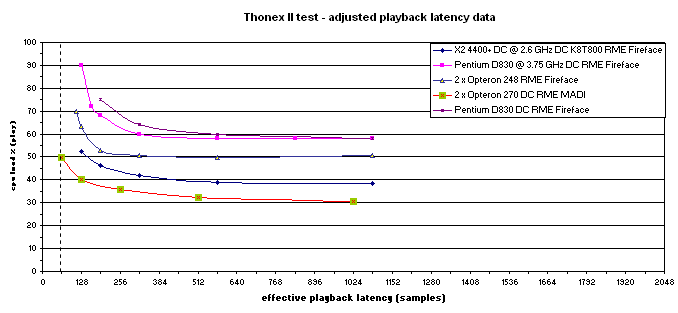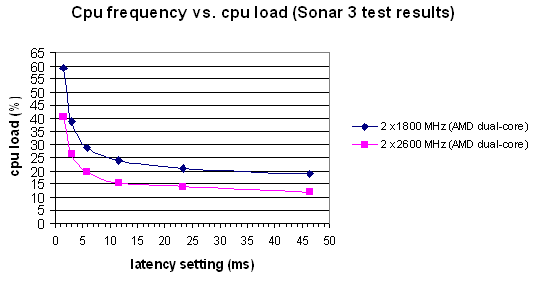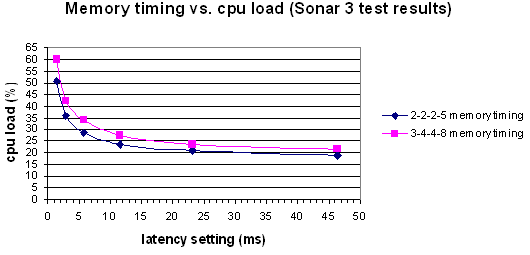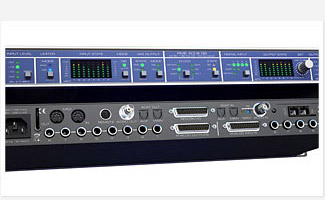Fahlens Corner
Notes on the Complexity of Measuring True Performance Differences with DAW Stress Tests
© AGRONOVA/Anders Fahlén 18.01.2006 Version 1.0Different DAW stress tests & configurations will not throttle your system in the same way
The original and Thonex II stress tests are known to throttle the DAW system harder (specifically in terms of VSTi/sample capacity) than e.g. the Sonar 3 test which should be taken into consideration. Case in point - the nForce4 with a single-core AMD 64 cpu may not act differently than other DAWs lacking the PCI-PCIe interconnectivity issue under light stress (Sonar 3, Five Tower), whereas performance differences start to become real when the PCI bus is throttled harder (Thonex, Thonex II).
Even different versions of drivers, DAW software and VSTIs will yield different stress test data - other variables kept constant. Thonex stress test data based on Nuendo 2 generally results in lower CPU loads than if based on the Nuendo 3.x version - all other factors kept constant. Different host software versions, as well as unstable systems, are known to yield varying or inconsistent CPU read off results and thus likely to cause skewed interpretations of the actual variable to be tested.
Stress test results will primarily mirror the mode of the test design itself and thus vary across different test platforms. From a user perspective, the important thing is to identify a test design which is a relevant reflection of real-world conditions likely to represent your DAW work (i.e. are you a hard hitter dependent on hundreds of audio tracks including a multitude of VSTi/samples, or rather dealing with multimedia work based on a limited number of audio/midi tracks ?).
Host/menu read-off latency vs. true latency in audio stress tests
When comparing DAW stress test data across various soundcards used, the reader should interpret any performance differences at a specific buffer setting cautiously as the soundcard's menu latency setting may not reflect real I/O latency values. The German magazine, Keyboard (04/2005), measured the latency performance differences on seven Firewire soundcards and concluded that the discrepancies between indicated software latency values and real roundtrip latency ranged from 0 ms up to 7.1 ms. The RME Fireface 800 was the only tested device that did not differ (software indicated vs. real roundtrip values).
It is also important to note that Firewire soundcard interfaces usually include additional safety buffer latency in playback mode compared to PCI soundcards (this is needed as Firewire devices lack Direct Memory Access, DMA, as PCI devices). Thus, when comparing audio stress test data using playback mode with e.g. the RME Fireface it will add 64 samples latency via its safety buffer. If all other variables are kept constant the effective playback latency, RME HDSP PCI vs. RME Fireface 800, would actually add 1.5 ms (64 samples) at 44.1 kHz in the latter case. This effect is illustrated in the following figures:

Figure 1. Thonex II/Nuendo 3.1 stress test results: CPU loadvs.menu latency settings.
Average read off CPU load values (play). Input data based on user reports submitted to the Nuendo Hardware forum.

Figure 2. Thonex II/Nuendo 3.1 stress test results: CPU load vs.adjusted playback latency settings. Average read off CPU load values (play). Input data based on user reports submitted to the Nuendo Hardware forum. Average read off CPU load values (play).
Preferably, audio stress tests should be conducted with the same audio interface and driver version2 across mainboard/chipset/CPU platforms as to reduce such latency artifacts.
2 buffer size information includes AD/DA conversion (1 + 1 ms) since RME Fireface driver 1.41 (11/2004); offset information increased by 1 sample since driver version 1.5 (12/2004). See http://www.rme-audio.com/. Impacts of memory timing & bandwidth differences on DAW stress test results
CPU frequency and memory bandwidth/timings have significant impacts on audio stress test results - keeping other variables constant. The performance difference usually increases as latency setting values become smaller as illustrated by the following graphs:

Figure 3. Influence of CPU frequency on CPU load (%) as measured by the Sonar 3 test. All other BIOS/Host software settings and hardware configurations kept constant. Input data based on user reports submitted to the Sonar forum.

Figure 4. Influence of memory timings on CPU load (%) as measured by the Sonar 3 test. All other BIOS/Software settings and hardware configuration kept constant. Input data based on user reports submitted to the Sonar forum.

Figure 5. Influence of host multiprocessing mode on CPU load (%) with AMD 64 X2 dual-core CPU as measured by the Sonar 3 test. All other BIOS/Software settings and hardware configuration kept constant. Input data based on user reports submitted to the Sonar forum.


Figure 6. Influence of memory timings & bandwidth (1T vs. 2T command rate) on average number of Magneto plugins able to play (1 st test run without reload) as a function of latency settings. Input data based on user reports submitted to the Nuendo Hardware forum.
One of the conclusions made from the graphs presented (figures 4 and 6) is that memory timings and bandwidth have a comparatively larger influence on performance in low latency DAW work than in most other software usages. This indicates that in cases where the CPU-memory sub-systems are stressed there is a real-world advantage of being able to tweak memory performance and using memory modules capable of tight memory settings. Among adjustable parameters influencing memory timings and bandwidth, the command rate (or clock per cycle, CPC), which regulates how system clocks are allocating timings of a command to the system, is likely to have the greatest partial impact (disregarding the potential impacts of NUMA and 32-bit/64-bit NUMA OS support with Opteron CPUs). Users with AMD 64/X2/Opteron CPUs having high-demands on performance at low latencies may want to verify if their combination of memory, BIOS and mainboard is capable of running at 1T command rate instead of the default value (2T). Such a tweak must though be verified to run stable over time.
Acknowledgements
Many thanks to Andrew K ("Thonex") who developed the Thonex original and Thonex II stress tests for Cubase/Nuendo, Vin Curigliano ("Tafkat") who developed and conducted the Blofelds DSP40 DAW stress test, Scott Reams who developed the Sonar 3 stress test, and ADK Pro Audio ("jschild") who has publicly submitted numerous DAW stress test results. Likewise, without users publicly giving feedback and details on public forum about their DAW stress test results the audio community would be weaker in knowledge than presently found. Kudos to all involved!
Impressum | Nutzungsbedingungen | Datenschutz
Copyright 2025 Audio AG for RME Operations

